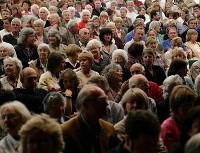 A new study, presented to the the world’s largest cardiac conference in August, 2016, detailed how different kinds and amounts of exercise by older people affected their heart health. Up until this point, studies had dealt with young to middle aged people.
A new study, presented to the the world’s largest cardiac conference in August, 2016, detailed how different kinds and amounts of exercise by older people affected their heart health. Up until this point, studies had dealt with young to middle aged people.
Particularly interesting was that the group performing high intensity exercise, like competing in ball games, running, swimming, etc. did not have excessively better results then those doing moderate exercise like gardening, walking or even fishing. Moderately exercising older people lowered their chances of a fatal heart attack by 54%, as well as lowering their chances of an acute heart attack or stroke by 31%. The intense exercisers did better, but not radically better. They had a 66% lower fatal heart attack rate, and a 45% lower rate of acute events.
Yes, that’s a pretty significant difference favoring the intense exercisers, but a lot of people are not physically capable of intense exercise like competing in ball games. So, knowing that moderate exercise, which is possible for nearly everyone, helps as much as it does, is extremely important.
Another important aspect of the study, was that the exercise does not have to be all at one time: Professor Joep Perk, cardiologist and spokesman for the ESC, said: “The message is start moving after retirement – it’s never too late.”
Emily Reeve, senior cardiac nurse at the British Heart Foundation, said: “In order to keep their heart healthy and improve general health, older adults need to keep active and still aim to achieve a minimum of 150 minutes of aerobic activity every week.
 Personally I like gardening for exercise because it incorporates the aspect of looking forward to tomorrow, to see what’s bloomed, how many strawberries are ripe, whether the kumquats are flowering, and whether the collards have survived the armadillo bugs.
Personally I like gardening for exercise because it incorporates the aspect of looking forward to tomorrow, to see what’s bloomed, how many strawberries are ripe, whether the kumquats are flowering, and whether the collards have survived the armadillo bugs.
My own experience of being so sick I could barely exercise for one minute, literally one minute, is that even that small amount of exercise made a positive difference. And, when I got up to 3 minutes a day, and eventually 5 minutes a day, I lost 60 pounds and 11 inches. 3 minutes a day is 21 minutes a week, which is effective and a lot LOT less than 150 minutes a week.
My feeling is that health care professionals ignore the limitations experienced by people who have been serioiusly ill for a long time.
You can see the difference 3 minutes of exercise a day made for me. See photos.
